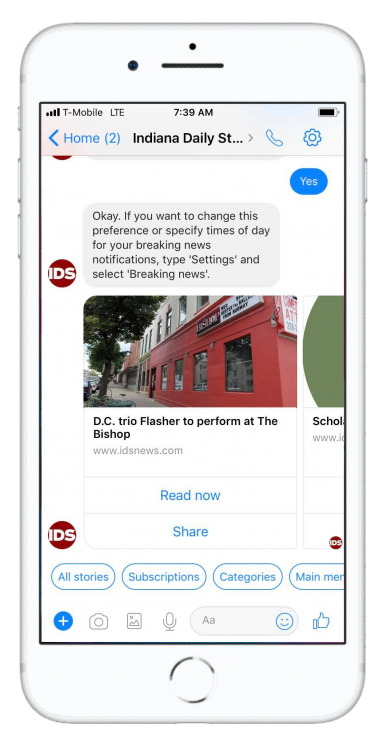Responding to consumer demand, IDS releases customizable news delivery bot
In response to a growing demand for customized news delivery — such as subscription emails and push delivery notifications — the Indiana Daily Student became the first college news source to release a customizable news service, the IDS Messenger, this semester.

Think of it as an app within an app. The IDS Messenger resides inside the Facebook Messenger app already on users’ phones and personalizes the news for consumers at times most convenient to them.
“We’re really trying to take on the stance of delivering news to people on any platform that they prefer,” said Greg Menkedick, creative marketing and advertising director for IU Student Media.
The IDS partnered with BotMaven, formed in September 2017 by several IU doctoral students, to create the first sustained college news bot. BotMaven began creating bots for the Eskenazi Art Museum and the Jacobs School of Music to enhance communication with their audiences.
Its third project was the IDS Messenger, following the lead of news organizations like CNN and the Wall Street Journal that implemented messenger bots to a less customizable degree.
“We’ve tried to improve upon everything we’ve seen in the field,” said BotMaven co-founder Tom Fennewald, MSEd’10, PhD’15.
The IDS Messenger takes 30 seconds to set up within the Facebook Messenger app. Start a conversation with the IDS and receive a prompt to select which news you’re most interested in seeing and at what time you’d prefer to receive those alerts. Set up once-daily alerts and decide if you want to subscribe to breaking news alerts. Unsubscribe or change your settings at any time.
These customizable features push this news bot ahead of the curve and enhance the user experience. After running the beta program inside the IDS office for the summer, the IDS made the service public.
The service gained 60 users in October and over 50 more in November, bringing the total number of active subscribers to more than 300 by the end of November. Fennewald said the service is likely to surpass 1,000 subscribers in the next year or so.
Right now, most of the users are early adopters and those at other media institutions scouting out the bot. The IDS expects an increase in retention rates alongside more new users as the technology becomes more familiar.
People seem to be hesitant to interact with an automated service, especially if they’ve never explicitly interacted with a bot, Menkedick said.
“I am confident that over time as users become familiar with not only our chatbot, but other chatbots in the industry, the adoption rates will increase,” he said. “This confidence comes from the successes seen across the industry with other customized news delivery methods, such as emails offering specific content and mobile push notifications in general.”
Fennewald said some people have interacted with a bot before but don’t realize it. Perhaps they’ve conversed with Alexa, Siri or a Google Assistant.
Considering the IDS’s Facebook engagement reached almost 70 percent of its social users in the past month, Facebook made the most sense as the site for a bot.
To create their bot, IDS staff and BotMaven sat down with a script of about 50 question-and-answer pairs. They set off trying to personalize the responses so users don’t notice the automation. It was simple details, like saying “Thanks!” or calling articles “stories” so it stays casual and personal.
“We knew it was a learning experience, so we didn’t overthink it,” Menkedick said.
So far, it is working. The open rate of the news alerts is 70 percent, and the click-through rate of breaking news alerts is 35 percent. These high engagement numbers are leading the industry. Menkedick thinks as more people hear about the service, the subscriber count will continue to grow with readers invested in Bloomington news.
“We want to create users that are engaged with our news,” Menkedick said.

